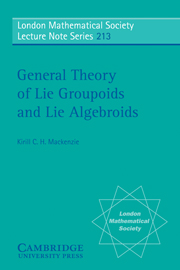Book contents
- Frontmatter
- Contents
- Prologue
- Introduction
- Preface
- TERMINOLOGY AND NOTATION
- ACKNOWLEDGEMENTS
- PART ONE THE GENERAL THEORY
- 1 Lie Groupoids: Fundamental Theory
- 2 Lie Groupoids: Algebraic Constructions
- 3 Lie Algebroids: Fundamental Theory
- 4 Lie Algebroids: Algebraic Constructions
- PART TWO THE TRANSITIVE THEORY
- PART THREE THE POISSON AND SYMPLECTIC THEORIES
- Appendix
- Bibliography
- Index
4 - Lie Algebroids: Algebraic Constructions
from PART ONE - THE GENERAL THEORY
Published online by Cambridge University Press: 05 April 2013
- Frontmatter
- Contents
- Prologue
- Introduction
- Preface
- TERMINOLOGY AND NOTATION
- ACKNOWLEDGEMENTS
- PART ONE THE GENERAL THEORY
- 1 Lie Groupoids: Fundamental Theory
- 2 Lie Groupoids: Algebraic Constructions
- 3 Lie Algebroids: Fundamental Theory
- 4 Lie Algebroids: Algebraic Constructions
- PART TWO THE TRANSITIVE THEORY
- PART THREE THE POISSON AND SYMPLECTIC THEORIES
- Appendix
- Bibliography
- Index
Summary
This chapter is concerned with the general concept of morphism of Lie algebroids. It is unusual for the definition of a concept of morphism to require much attention. However the bracket of a Lie algebroid is defined not on the vector bundle but on its module of sections, and a morphism of vector bundles does not generally induce a map of sections. We handle this problem by considering first the case in which the target Lie algebroid may be pulled back across the base map; when this is possible, the definition of morphism presents itself naturally, and may-then be reformulated so as to be viable when the pullback does not exist.
This procedure requires that pullbacks of Lie algebroids be defined before a concept of morphism can be formulated. The pullback notion for Lie groupoids of §2.3 has a clear analogue for Lie algebroids, and we proceed from this, justifying it retrospectively in 4.3.6 once the general notion of morphism has been defined.
The key to this chapter, as with Chapter 2, is the fact that the principal algebraic constructions for Lie algebroids may be characterized in terms of morphisms of specific types. This makes it possible to bypass a considerable number of explicit calculations. Rather than explicitly differentiating the algebraic constructions of Chapter 2, we proceed by analogy — based on diagrams and some very basic categorical principles — to define corresponding notions for abstract Lie algebroids.
- Type
- Chapter
- Information
- General Theory of Lie Groupoids and Lie Algebroids , pp. 148 - 178Publisher: Cambridge University PressPrint publication year: 2005

